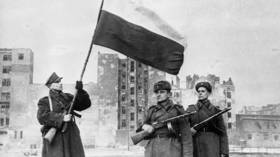When it rains (nukes), it pours: Cold War nuclear tests had heavy impact on weather & rainfall, new research finds
A flurry of nuclear weapons tests carried out amid the Cold War arms race may have had a profound impact on weather patterns across the planet, increasing rainfall thousands of miles away from testing sites, a new study found.
Using historical records from a research facility in Scotland dating back to the peak of the Cold War, a team of scientists compared day-to-day changes in the electric charge flowing through clouds following “the release of artificial radioactivity” – unleashed by nuclear explosions, that is – to determine how the bomb tests affected rainfall. Their findings were published in the Physical Review Letters journal on Wednesday.
Also on rt.com Even ‘small-scale’ nuclear war between India & Pakistan would DEVASTATE global food supply – studyThe team assessed data gathered between 1962 and 1964 – around the time of the Cuban Missile Crisis, during which the United States and the former Soviet Union carried out hundreds of bomb tests – finding that on days with greater radioactivity, rainfall was up by 24 percent on average and clouds were “optically thickened.”
“By studying the radioactivity released from Cold War weapons tests, scientists at the time learnt about atmospheric circulation patterns. We have now reused this data to examine the effect on rainfall,” said Giles Harrison, the study’s lead author and a professor of atmospheric physics at the University of Reading.
The politically charged atmosphere of the Cold War led to a nuclear arms race and worldwide anxiety. Decades later, that global cloud has yielded a silver lining, in giving us a unique way to study how electric charge affects rain.
While largely confined to remote areas of the world, such as deserts and uninhabited islands, the nuclear bomb blasts ionized the atmosphere and generated an electric charge which could alter weather patterns thousands of miles away from test sites, the researchers found.
Also on rt.com Pity they don’t work against Covid-19: US drives RECORD global spending on atomic weapons, report showsSince the first successful test in the summer of 1945, some 2,058 nuclear bombs have been detonated all over the planet – including the two American devices dropped on Japanese cities during World War II – according to the Arms Control Association. While the majority of the trials were conducted underground, over 500 atmospheric tests were carried out between 1945 and 2017.
Though the Cold War and its associated arms race waned with the dissolution of the USSR, nuclear tests haven’t ceased entirely, and the new findings could shed light on their ecological impact going forward. The research could also advance the field of geoengineering, providing insight into how electricity might be used to influence weather patterns.
Like this story? Share it with a friend!













